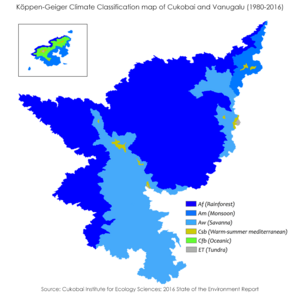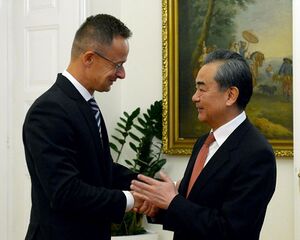Sandbox:Mannatiua
Geography


The landmass of Cukobai is divided between its mainland territory on the continental portion of Lautania and the Vanugalu Islands in the Deris Sea. At 581,875.8 km2 (224,663.5 sq mi), Cukobai is the largest country in Lautania by land area. The mainland is defined by five distinct ecoregions, from west to east - the Derisian (or West Cukobaian) Rainforest, Tikatika High Plateau, Sungailama River Basin, the Tanatinggi, and Pasebasu. While the Derisian and Sungailama Rainforests are actually part of a single contiguous rainforest ecosystem which covers 85.9% of the country's continental landmass, the difference in hydrology makes for significant differences in flora, fauna, and ease of access or settlement by humans. The coastal plains on average extend from 15 to 150 kilometers (9 to 93 mi) from water's edge, though significant variability exists.
The Derisian Rainforest region reaches an average elevation of 90 meters (295 ft) above sea level. It is marked by rolling and hilly terrain, and is exceedingly hot and humid, marked by a short dry season, and is home to some of the wettest places in the world. The coastlines contain a number of major settlements, including the nation's capitol, Bandar Cukobai, and plays host to key fisheries and economic zones. Additionally, the Inner Derisian, sometimes considered part of the Tikatika ecoregion, plays host to the bulk of the nation's coffee-growing operations, one of the country's historic exports. While the presence of agriculture has expanded along the western coastlines in recent years, the overall soil topology of this area is poor for continued cropping, as the topsoil, while carbon-rich and productive, is exceedingly thin and vulnerable to excessive tillage or disturbance, and subsoil zones are largely composed of rock and loose, unstructured sediment.
The Tikatika High Plateau rises from the coastal plains at about 650 meters (2,133 ft) above sea level. The alternation between wet and dry seasons are much more even, allowing for a generally comfortable, less humid climate. Soils here are markedly fertile, and hosts nearly all of the country's livestock and grain farming thanks to this and the region's generally level terrain. Historically, most non-coastal settlements have been established here, thanks to its ease of farming and travel.
The Sungailama River Basin is one of the most biodiverse regions in the world, composed of a rich riparian landscape with dipterocarp, swamp, and mangrove rainforests. Peat swamp forests occupy much of the basin's northern coastline. Erosion of the region's limestone bedrock by the Sungailama River and its tributaries have carved a number of dramatic features and karst topography, including some of the world's largest cave systems. However, this is considered an older geographic feature of the continent at large, and thanks to this elevation generally reaches 760 meters (2,493 ft) above sea level at its highest, with greater elevations encircling it to the southwest and east giving way to the Tikatika and Tanatinggi highlands, respectively. This rainforest is considered the wettest area in Lautania, and because of that has historically made mass settlement difficult, with key locales being settled along the Sungailama, as its terminus at Belau makes it critical for regional and global trade. While homesteading further inland has been encouraged by the national government, the practice is often faced with fierce criticism from local indigenous communities and conservationists alike, making any serious attempts at settling new areas in the Sungailama for economic development virtually nonexistent in recent decades.
The Tanatinggi highlands are host to the coolest, most temperate regions of the country, and includes the only true mountains, the Tangatatapu Range which mark a portion of the nation's border with Iuliania, as well as only portions of mainland Cukobai that experience snowfall annually. At 4,095.2 meters (13,436 ft), Gunungputih, sometimes referred to as Mount Bianca abroad (especially by Aesculians), is the highest point in Cukobai. Aside from
The Pasebasu is a low-lying, relatively dry region in comparison to the rest of the nation, which extends from the eastern foot of the Tangatatapus into Iuliania. It is the only portion of the country which experiences monsoon rains, and thanks to its placement in a modest rain shadow, does not experience the same degree of humidity that covers the bulk of the national mainland. This region has the smallest coastal area of all Cukobai's ecoregions at only 28 kilometers (17.39 mi) of shoreline, as the coastal swamps of the Derisian-Sungailama Rainforest system reaches its northernmost extent there. Thanks to its extended dry season, a wider variety of crops can be grown here, including the nation's famous saffron fields, as well as Cukobai's only internationally-recognized wine-producing regions.
Government and Politics
Districts
- Main Articles: Districts of Cukobai, Federal Cities of Cukobai

Municipalities and Communes
Foreign Relations
- Main Article: Foreign relations of Cukobai

Since its establishment as the sole legitimate government of Cukobai in 1914, the foreign policy of the federation has changed dramatically with their geopolitical situation in order to keep a degree of fluidity on the world stage, though there have generally been a tendency towards three overarching priorities. The first is economic and political solidarity with the nations and peoples of Lautania, especially aimed at encouraging the adoption of republican modes of government and development of diverse, stable societies - which Cukobai attempts to foster through consistently acting as a mediator in contentious political or military issues. A special emphasis is placed on maintaining ties with their main ally in efforts in regional decolonization, Whaeamoe, and outreach to independence movements within the neighboring Aesculinese territory of Iuliania. The second is ensuring the safety of trade in the Deris Sea and the Southern Lautan Ocean, and cooperating with other nations and organizations to curb piracy therein. The third is military non-interventionism, especially outside of Lautania, though the nation does not accept irrevocable neutrality as a viable prospect in world politics. Military resources are primarily devoted to acting towards peacekeeping efforts, disaster relief, and securing of the nation's vital waterways, frontiers, and border regions.
Disputed Territorial Claims
Due to its contentious period of suzerainty in the sphere of the Aesculinese Colonial Empire from 1792 to 1914, the modern Cukobaian Federation continues to seek a return of areas settled by ethnic Dusunpans in Iuliania during the peak of the Sultanate period, which were gradually taken as part of concessions for the War of 1866 and as part of the Belau Agreement at the close of the Second Cukobaian Revolution and reestablished Cukobaian independence. Additionally, the Agreement established the nation of Whaeamoe as an independent republic, though its status as a formerly integrated region of the Sultanate has led some Cukobaian irridentists, as well as anarchist groups within Whaeamoe to seek a reunion of these nations.
Separatist and Irridentist Movements
Internally, ethno-nationalists have sought to carve their own independent states from the Federation, or to rejoin other nation-states, both throughout the history of the nation and presently. Nearly every ethnic community in Cukobai has a fringe movement that has participated towards the completion of one of these aims, though among the most prominent since the establishment of the Federation have been Dusunpan supremacists and Indigenous nationalists.
The Black Days in particular, which rocked the nation in the 1940s and was a major precipitating incident in the reorganization of Cukobai into its modern constitutional form, was instigated by a far-right Dusunpan extremist organization known as the Princely Army which triggered a brief border war with Aesculinese security forces in Iuliania, This exchange was intended to create a new Sultanate in Lautania modeled after the short-lived [X] military junta which existed contemporaneously with the chain of aborted revolts. It is for this reason that irridentist movements for the annexation of Dusunpan-majority regions of Iuliania are often dismissed as fringe (and often dangerous) beliefs for its linkage to the Black Days.
Veigalun peoples, which were often the most targeted by the Princely Army during the Black Days, as well as by centuries of abuse under the Sultanate, felt that the anarchist government as established under the 1910 Universal Declaration of Human Liberty had failed to prevent historic mistreatment by colonial Dusunpans and Aesculinese, and sought to establish their own ethno-states which would remove the offending colonial populations and influences, an effort largely focused on the island of Vanugalu. In 1951, a united Veigalun Liberation Army seized a Black Army weapons cache and dockyard located in Nakeba, prompting the beginnings of the Vanugalu War, a fierce guerrilla campaign which caused significant damage to the economy and reputation of the still-developing Federation. The conflict was brought to a ceasefire and peace agreement following the ratification of the 1953 Constitution, when greater protections for non-Dusunpan minorities and anti-discriminatory educational programs were given high priority under the new government arrangement. However, protests among Veigalun people have endured over the years due to historic underemployment and other economic hardships, as well as land developments which conflicted with the authority of local governments, most notably in and around the Gunungangin region of Vanugalu, where a number of research facilities and tourist areas have been developed over the latter half of the 20th Century. Because of the disdain of the locals for non-Veigaluns, this has become an area rife with anti-federalists, with some theorizing that such attitudes were responsible for the dissapearances and supposed deaths of 60 scientists from Huajiang and the Cukobaian mainland at the Barupertama Observatory in July of 2019.
Military
- Main Article: Cukobai Revolutionary Defense Forces
- Further Information: List of wars involving Cukobai
The Cukobai Revolutionary Defense Forces (CRDF) is the sole military apparatus of the Federation, and is headed by the General Staff, which is composed of elected officials from within the chief officers of each service branch, which acts in many ways similar to the National Directorate, which the General Staff is ultimately subject to the authority of. The branches present under the banner of the CRDF is the Black Army, Navy, Air Force, and the Support Services. Additionally, the CRDF draws upon the resources and assistance of the Niruvanam, Cukobai's national intelligence service, as well as the Kaval, the national law enforcement agency when necessary. The current charter of the CRDF states that its organization is solely for defense of Cukobaian territorial integrity, the security of domestic economic, social, and political interests, and international peacekeeping or disaster relief missions. The CRDF is not permitted to join ongoing military conflicts unless a direct threat to Cukobaian interests is observed, and even then requires the express approval of both houses of the Combined Assemblies.
Under its current form, the CRDF is a fully volunteer military. While general peacetime conscription is illegal under the constitution, the Directorate can call for its instatement in times of national emergencies. Due to its historic rivalries with nearby states and hostile imperial powers, all citizens receive emergency preparedness and basic marksmanship skills training. Citizens over the age of 18 are required to keep and maintain two working government-issue firearms: the PTP-89 and PTS-02 (a 9×19mm Parabellum semi-automatic pistol and submachine gun respectively), as well as undergo regular retraining seminars every five years. Beyond this, many citizens of Cukobai own additional firearms, mainly long rifles and shotguns, usually for the purposes of pest control or hunting. This is especially true in less-developed areas, where hazards caused by local wildlife are more prevalent in day-to-day life.
Compared to many countries of similar development and economic size, Cukobai has a comparatively small portion of its total gross domestic product going to national defense.




